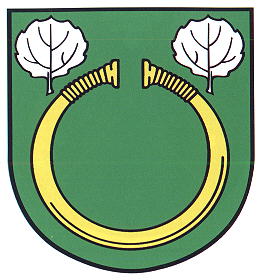Großenaspe: Difference between revisions
Jump to navigation
Jump to search
Knorrepoes (talk | contribs) m (Text replacement - "/Arms of " to "/Arms (crest) of ") |
Knorrepoes (talk | contribs) m (Text replacement - "{{media}}" to " {{de1}} {{media1}}") |
||
| Line 25: | Line 25: | ||
The main charge in the arms is a Bronze Age (8th century BC) bracelet found in 1860 in the municipality. It thus refer to the longtime inhabitation of the area. The two aspen (Espe) leaves are a canting element. | The main charge in the arms is a Bronze Age (8th century BC) bracelet found in 1860 in the municipality. It thus refer to the longtime inhabitation of the area. The two aspen (Espe) leaves are a canting element. | ||
{{ | |||
{{de1}} | |||
{{media1}} | |||
[[Civic Heraldry Literature - Germany|'''Literature''']]: Kommunale Wappenrolle Schleswig-Holstein | [[Civic Heraldry Literature - Germany|'''Literature''']]: Kommunale Wappenrolle Schleswig-Holstein | ||
Revision as of 11:31, 26 December 2022
This page is part of the German heraldry portal Deutsche Wappensammlung |
Heraldry of the World |
|
German heraldry:
|
Selected collector's items from Germany:
|
GROSSENASPE
State : Schleswig-Holstein
District (Kreis) : Segeberg
Amt : Amt Bad Bramstedt-Land
| German |
In Grün ein goldener Eidring, begleitet in den Oberecken von zwei silbernen Espenblättern. |
| English | No blazon/translation known. Please click here to send your (heraldic !) blazon or translation |
Origin/meaning
The arms were officially granted on September 19, 1977.
The main charge in the arms is a Bronze Age (8th century BC) bracelet found in 1860 in the municipality. It thus refer to the longtime inhabitation of the area. The two aspen (Espe) leaves are a canting element.
Literature: Kommunale Wappenrolle Schleswig-Holstein


